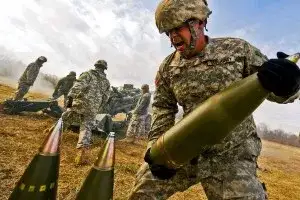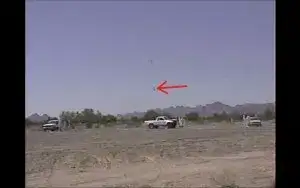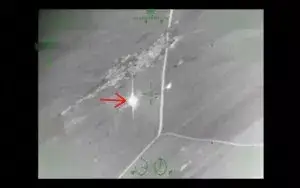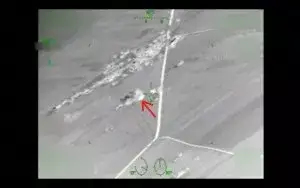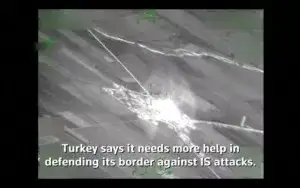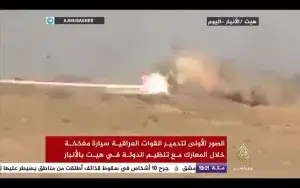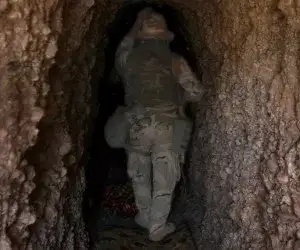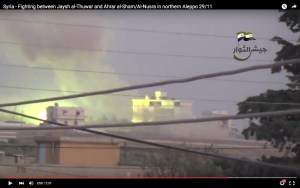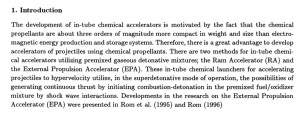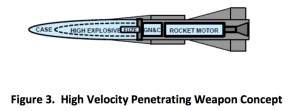Projectiles that go very, very fast and hit very, very hard
May 9, 2023 by Thomas Wictor
Today I was able to flesh out more of the development of what I call Israeli-Arab EMPFAE ordnance, munitions that have two parts: 1) a warhead for producing nonnuclear electromagnetic pulses (EMPs); and 2) fuel-air explosives (FAE). Israel has been working on hyper velocity projectiles (HVPs) for years. It appears that in the process of perfecting super-fast munitions, the Israelis also created the devastating FAE that we’ve seen in Syria and Iraq.
These weapons have multiple uses. They produce such intense heat that they incinerate enemy explosives, reducing their destructive power.
And the shock wave of EMPFAE can be used to “flatten” explosions that the enemy creates.
The horizontal smoke cloud is one signature of the new weapons.
I figured that they were almost certainly chemical explosives.
Guess who was right?
Hyper velocity projectiles
Why would you want HVPs? Well, let BAE Industries explain.
The HVP’s low drag aerodynamic design enables high-velocity, maneuverability, and decreased time-to-target. These attributes, coupled with accurate guidance electronics, provide low-cost mission effectiveness against current threats and the ability to adapt to air and surface threats of the future.
The high-velocity compact design relieves the need for a rocket motor to extend gun range. Firing smaller, more accurate rounds decreases the likelihood for collateral damage[.]
Here’s a video of the US Navy HVP that’s in development.
This model HVP will travel at Mach 3 (2284 miles per hour, 3676 kilometers per hour).
Israel beat us to it, and they’ve given these projectiles to Turkey. Video proves it.
Turkish projectiles
Despite claims to the contrary, Turkey is fighting the Islamic State. The Turks use their T-155 Fırtına self-propelled howitzers to fire rounds into Syria.
The 155mm round is small.
It’s easily caught on video because by the time it hits the target, it’s traveling at about 756 miles per hour (1217 kilometers per hour).
Recently Turkey engaged the Islamic State with 155mm howitzers.
Turkish shelling killed 55 Islamic State insurgents in northern Syria on Saturday, military sources said, in retaliation for weeks of rocket attacks on a Turkish border town.
Artillery fire hit the regions of Suran and Tal El Hisn north of Aleppo, as well as Baragidah and Kusakcik, taking out three rocket installations and three vehicles in addition to killing the militants, the sources said on Sunday.
That link has a video that I can’t embed, but it proves that the Turks are using HVPs. For one thing, the accuracy of this long-range fire is amazing. Below is a direct hit on a rocket installation.
That’s an enormous explosion, the size of several houses.
This is a hit on personnel.
Even that explosion is gigantic. Below is how a normal high-explosive 155mm artillery round detonates.
The Turkish 155mm rounds are precision guided, they travel too quickly to be captured on video, and they cause tremendous-but-concentrated damage. They’re new munitions.
Here’s another direct hit on a rocket installation.
While the US is still testing HVPs, Turkey is already using them in combat. These munitions were invented by Israel. The Turks use them in a conscious decision to limit collateral damage.
Projectiles for all seasons
In 1990, the Rafael Ballistic Center in Haifa created a stable explosively formed hyper velocity projectile (EFHVP) that traveled 26,844 miles per hour (43,201 kilometers per hour) or Mach 35.
The video below was taken in Iraq. It shows a missile traveling at Mach 18.
The problem that always stymied the rest of the world was that when projectiles went too fast, the friction of the air melted them. Israel has clearly solved this issue. How?
Nobody knows. Except the Israelis and the Arab League. The men using the new weapons have to be Arabs. Although the Kurds are ready to accept open help from Israelis, it’s simply too soon for most of the region’s Muslim Arabs. However, the change will happen much faster than you think. The men who shot the hypersonic missile above had to be Sunni Muslim Arabs, allies of Israel.
Below is a Saudi commando in an Islamic State tunnel under Kharbardan, Nineveh province, Iraq.
Men raised on Wahhabism are fighting for Shia, and virulently anti-Saudi Shia are accepting their help. The Shia militia in Iraq were considered by many to be as bad as the Islamic State. All of that has changed. The combination of discretion, empathy, and incomprehensibly destructive weapons has made most people in the Middle East see the light.
Live and let live, or you die.
Projectiles need propellants
A video of Arab League strategic special operators in combat convinced me that the new Israeli weapons use chemical explosives.
The explosion above had a distinctly greenish tint, it produced no smoke, and it was abnormally violent. All high-explosive munitions are technically chemical reactions, but most rely on some form of heat as the primer. Such detonations have an orange tint and create lots of smoke.
I found multiple patents for binary warheads that would allow for massively powerful chemical fuel-air explosives, and now I discovered something else. The book Ram Accelerators: Proceedings of the Third International Workshop on Ram, edited by Kazuyoshi Takayama and Akihiro Sasoh (Berlin and Heidelberg: Springer Verlag, 1997), has this on page 167.
“Rom” is Professor Josef Rom, Department of Aerospace Engineering, Israel Institute of Technology, Haifa.
In researching hyper velocity projectiles, Professor Rom pointed Israel in the direction of creating explosive gases—fuels and oxidizers that would be mixed in a tube.
Thus we see that in the 1990s, the Israeli work on weapons built for speed dovetailed with the research on what became fuel-air explosives. Once the Gulf Cooperation Council began pouring in funds, all these ideas went from theoretical to actual.
Over twenty cameras were pointed at the missile base in Faj Attan, Sanaa, Yemen, on April 20, 2015. That means advance warning was given. War is not supposed to be nice, but even so, all the evidence indicates no civilian casualties.
The shock wave is what makes this new Israeli-Arab weapon different from everything that came before it.
The rising superheated column sucked up the cold air around it. Clouds of dust reversed direction.
The high velocity penetrating weapon (HVPW) did that.
Before all you Israelis start banging your heads on the floor with guilt, remember this: The new weapons produce virtually no collateral damage. Even that massive explosion at Faj Attan didn’t kill anybody. Initial reports said, “There were no casualties.” Only later did the Houthis claim that civilians died. It’s a lie.
This is why all thinking people must reject the accusation that Israel in any way resembles Nazi Germany.
When the Israelis decide to be Nazis, you’ll know it by the field of corpses that covers multiple continents. Israelis are anti-Nazis. Ask the Arab League and Turkey. We can now fight major wars without killing ANYONE, even combatants.
Thank Israel.



